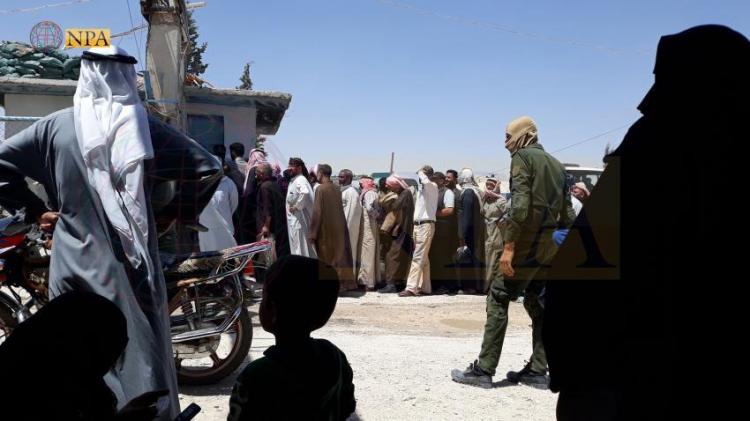Inside and Outside Al-Hawl Camp, Syrian Women Tell Their Stories in Pursuit of Safety
North-Press Agency
Al-Hawl camp, Hasakah / Raqqa –Abdullatif Hilal
“It was the safe haven and land of life and survival”, with these words Raja Ali Al-Ahmad described Al-Hawl camp where she left, along with other 800 women and children of the Islamic State militants, a few days ago.
Earlier this month, the administration of Al-Hawl camp, northeast of Syria, handed over women and children of ISIS militants to Labor and Affairs Board in order to send them back to their homes as tribal leaders in the region demanded their release under “sponsorship”.
Raja refused to be filmed by “North Press Agency” correspondent in Raqqa where she returned to live with her father-in-law, she justified her refusal saying that she fears that this would cause problems for her, especially by the people who were abused by ISIS militants when they controlled the city.
“Soon after we felt safe inside the camp, it became like a prison to us and we wanted to get out of it,” Raja added.
“I haven’t seen any of these lies”
As for her experience with ISIS, Raja says she was convinced that “People here are infidels, as they told us that they prevent people from praying and fasting, the mosques have been demolished and that women are prevented from wearing the hijab,” After being silent for a while, she continued “but I haven’t seen any of these lies.”
Raja pointed out that service inside the camp was good, but the large numbers of IDPs, lately, led to the lack of some needs, explaining that medical service and first aid were “very bad”.
While, Zahra Ali Al-Mishaal, Raja’s mother-in-law, was grateful for the return of her son’s wife and grandson by saying “The day Raja came out from the camp, our house was very crowded with visitors to congratulate us.”
The Islamic State group took control of Al-Hawl area back in 2015 during its expansion in the north and eastern territories of Syria, as it has strategic importance, therefore, Al-Hawl became one of the main strongholds of ISIS in northeastern Syria.
In November 2015, the US-led Global Coalition backed Syrian Democratic Forces managed to liberate the area from ISIS, after fierce battles and a large military campaign.
As fighting continued between SDF and ISIS in the last strongholds of the latter, particularly in Al-Baghouz east of Deir ez-Zour, Al-Hawl camp became a safe haven for ISIS escapees and detainees, especially for their wives and children.
Recently, after collaboration between the Autonomous Administration and the Arab tribes in the region, the administration of the camp began the process of taking 800 women and children out of the camp to their home areas in Raqqa and Tabqah.
What about the others inside the camp?
Jouriya Ahmad Al-Mousa, a wife of a former ISIS militant who surrendered to SDF, she remains in the camp, told “North Press Agency” correspondent that she wasn’t taken out with the previously mentioned group, because her ID is registered in the town of Al-Safira, eastern Aleppo, which delayed her exit from the camp.
In the same context, Afnan Issa Rajab (Jouriya’s father-in-law), said that he visited his son’s family in the camp more than twice, he described the camp as “A city-like with all the necessities of life, including foodstuffs, transportation, medical service, and others.”
While “Hewedi Al-Shalash”, Sheikh of “Al-Afadelah Albo Shaaban tribe”, stressed that the coordination with the Autonomous Administration is still ongoing and that the rest of people inside the camp will be released, but after “investigations and authentications”.
Despite the exit of successive groups of ISIS families, Al-Hawl camp witnesses a massive movement and heavy crowding during times of visits, and according to the latest statistics of Doctors without Borders Organization (MSF), the number of inhabitants is about 73k persons.
The establishment of the camp dates back to 1991 during the Gulf War where High Commissioner for Refugees (UNHCR) established an Iraqi refugee camp south of the town and was activated in line with the Syrian government, following the 2003 Iraqi war, the camp was reopened.
After the SDF control of the area, they rehabilitated the camp, and in April 2016, Al-Hawl camp was reopened to all refugees, especially Iraqis.

